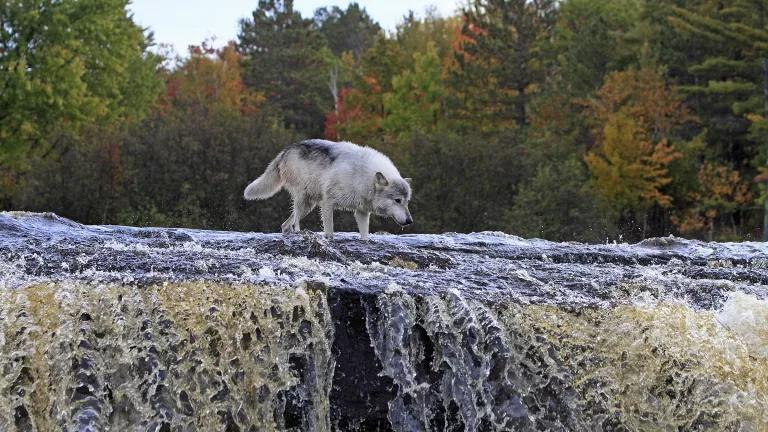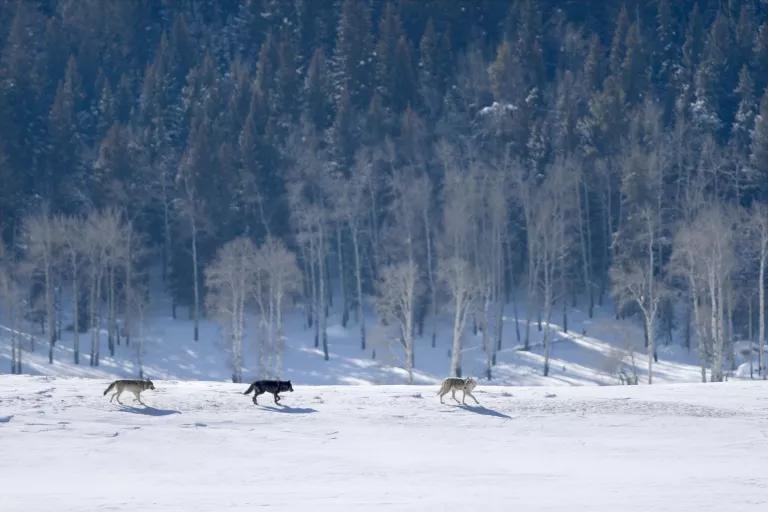America’s Gray Wolves Get Another Chance at Real Recovery
After getting last year’s unlawful delisting rule reversed, NRDC is setting the stage for stronger wolf conservation.

Gray wolf walking along a waterfall in Minnesota
Getty Images
When the iconic gray wolf first appeared under the Endangered Species Act (ESA) nearly 50 years ago, it had all but disappeared from the nation’s landscape, due to aggressive hunting, trapping, and habitat loss. Typically, a species remains on the Endangered Species Act list until the population is no longer in danger of going extinct. But that’s not how it has gone for the gray wolf.
In November 2020, the U.S. Fish & Wildlife Service (USFWS) finalized a rule that stripped the species of federal ESA protections, citing its “successful recovery.” In actuality, these animals remain absent from much of their historic range across the country.
In response to the delisting, NRDC and its partners took the USFWS and the U.S. Department of the Interior to court and, this past February, a judge restored protections for gray wolves across 44 states. The victory represents a critical moment for conservation and is the most recent in a series of important steps meant to ensure the gray wolf truly recovers.
The Unfortunate History of Wolves in America
Gray wolves went from roaming nearly all of the contiguous United States in the 19th century to being hunted to the edge of extinction by the middle of the 20th century. A government-sanctioned extermination plan—fueled by a broader push to domesticate the landscape and expand grazing ranges—was largely to blame.
The consequences of such a wide-scale eradication, of course, go beyond one species. As a top predator and a keystone species, gray wolves play an essential role in maintaining the health of their ecosystems. A sudden decline in wolf populations can trigger an ecological collapse, as it did in Yellowstone National Park in the 1920s. Research has also suggested that the presence of wolves could help mitigate the impacts of climate change. In the boreal forest of Canada, which is a critically important carbon sink, gray wolves directly influence the behavior and abundance of moose, thereby indirectly shaping the forest’s composition and increasing its carbon storage. Wolves are also culturally significant to many Indigenous groups and sacred to some.

Wolves in Yellowstone National Park
iStock
Once there was a better understanding of the wolf’s value and the importance of biodiversity, attitudes toward the animal slowly began to change, and in 1974, the gray wolf received federal protections under the ESA.
Since then, populations have steadily increased in a few areas. There are about 4,200 wolves in the Great Lakes region and 2,000 to 3000 in the Northern Rockies. However, despite the significant strides, including a successful reintroduction of wolves in Yellowstone, gray wolves are still endangered or nonexistent throughout most of their historic range.
The lack of a national recovery plan has been a problem for both the wolves and the USFWS. For the wolves, it has meant not achieving full recovery, a requirement for delisting. For the USFWS, it has been the main reason why its previous attempts to delist the wolf have failed. “The USFWS has always been stumped with delisting efforts because…it has no intention of recovering wolves across the board,” says Dr. Sylvia Fallon, senior director of science integration at NRDC. “The USFWS has chosen to focus instead on specific regions and develop separate recovery plans, some of which are now more than 30 years old and lack up-to-date scientific backing.”
The Wolf’s Eventual Delisting
The USFWS was eventually able to finalize a proposal to remove ESA protections under the Trump administration. In March 2019, the agency stated that gray wolves no longer needed federal protections because of the successful recovery rates in the Great Lakes region. This, it argued, was enough to sustain the species.
The proposal did not include Mexican wolves, which the USFWS listed separately as an endangered subspecies, nor the wolf population in the Northern Rockies, which had already been delisted in 2011 (in Montana and Idaho) and 2017 (in Wyoming).
NRDC submitted comments to the USFWS’s initial proposal to delist the gray wolf in July 2019, urging the agency to keep the wolf’s protections intact and focus on national recovery efforts. The USFWS instead pushed forward, and NRDC took them to court in January 2021, along with Earthjustice and the Western Environmental Law Center, which filed their own lawsuits.

A gray wolf in Minnesota
Shutterstock
The NRDC lawsuit argued that the rule violated the ESA and the Administrative Procedure Act when it justified delisting the species based on a single population’s revival. “They essentially drew a circle around the Great Lakes and didn’t look at anything else,” says Frank Sturges, NRDC’s lead attorney in the case.
The delisting also created immediate dangers for the country’s remaining wolves, because management and protection plans fell to individual states. Unfortunately, states do not have much incentive to pursue comprehensive wolf management, and some even took the chance to aggressively attack gray wolf populations within their borders. For example, in just three days during Wisconsin’s first wolf hunt since the delisting, hunters killed 218 wolves—nearly 100 animals over the hunt’s intended limit and 20 percent of the state’s wolf population.
That number alone is shocking, but as Jennifer Sherry, wildlife scientist and policy specialist with NRDC’s Nature Program, points out, we should also consider the broader effects on wolves, which are highly social animals. “When you disrupt their social structure, it can have negative impacts on wolves in ways that might not be reflected in the numbers alone,” she says.
Thankfully, on February 10, 2022, a U.S. District Court issued an especially strong ruling that restored protections. The judge ruled that not only did the USFWS fail to evaluate the status of wolves across the country, but it also didn’t properly identify and interpret what a “significant portion” of the gray wolf’s range means, adequately assess the wolf’s threats across its range, or evaluate the impact of lost historical range on the species.
The federal government has until late April to appeal the court decision. Hunter advocacy groups and the state of Utah have already appealed.

Wolf paw print tracks on Fountain Freight Road in Yellowstone National Park
Jacob W. Frank/NPS
Rethinking the Wolf’s Future
While the federal reversal is a great step, the type of disastrous state mismanagement exhibited during the delisting period continues in the Northern Rockies, where gray wolves remain unlisted.
“In 2011, after wolves were delisted in Montana and Idaho, both states quickly offered wolf hunting seasons,” Sherry says. “What we’ve seen more recently is a political co-opting of wolf management decisions, leading to extremely aggressive policies that have no scientific basis.” Last year, Montana passed several anti-wildlife bills that openly aim to reduce the state populations of wolves and other large predators. Shortly after, Idaho passed a bill that allows hunters, trappers, and private contractors to kill up to 90 percent of the state’s wolf population.
Unfortunately, the delisting in Montana and Idaho cannot be challenged in court as it was passed through a congressional rider—a provision tacked on to an unrelated bill. Nor can Wyoming’s delisting. But there are other ways to get the attention of the USFWS, which has the authority to change this. In July 2021, several conservation organizations filed a petition asking the agency to relist the Northern Rockies population under the ESA. NRDC is also urging Interior Secretary Deb Haaland to consider the inadequacy of current state policies.

A gray wolf in Kalispell, Montana
Getty Images
At the national level, NRDC is advocating to establish a comprehensive recovery plan for gray wolves. To do so, NRDC experts say the USFWS needs to look at where there is available habitat for wolves to thrive, think about whether these populations need to have connectivity between them, and develop a coordinated, holistic approach across the entire Lower 48.
Their recovery also has to be about more than a population number. “We have so much room for wolves in this country, but some states are trying to suppress wolf numbers to a bare minimum based on fear mongering and misunderstanding of the role of top predators within an ecosystem,” Sherry says. “Wolf recovery is also about shifting our relationship with nature to one of reciprocity, rather than competition and conflict.”
A major factor in wolf mortality and the anti-wolf sentiment is conflict between wolves and livestock. This is why NRDC has been working to advance healthy coexistence practices by collaborating with agencies like the USDA’s Wildlife Services, which farmers and ranchers often call to remove predators from their lands.
“We’re working to increase support to those who have livestock and are living near wolves by offering them a suite of nonlethal tools for protecting their animals,” Sherry says. By implementing preventative solutions, such as proactively setting up turbo fladry, a type of temporary electrical fencing, Wildlife Services can protect both livestock and wolves.
NRDC has seen immense success in this work, especially in the Northern Rockies. What started off as a tentative partnership between NRDC and Montana Wildlife Services has grown into an effective and collaborative effort to promote coexistence work throughout the state. NRDC and partners have even helped Wildlife Services develop new positions dedicated to nonlethal conflict prevention and coexistence work. The agency has also expanded the initiative across many other states, including California, Colorado, Idaho, Minnesota, and Oregon.

Jennifer Sherry, wildlife scientist and policy specialist at NRDC, helping install fladry fencing to prevent wolf–livestock conflicts in an Idaho calving pasture
USDA Wildlife Services
And to make sure it can all be paid for, NRDC has successfully lobbied Congress for increased funding and resources for federal agencies like Wildlife Services to ramp up such programs.
This is how we set up gray wolves with a real chance to fully recover in the United States. And despite the seemingly endless legal fights around federal wolf protections, Fallon remains optimistic about the future for the species: “I see this recent court win as an opportunity for the USFWS to get it right this time. What they are doing now is clearly not working. Let’s go back and look at this again. Let’s get it right.”
Let’s save the wolves, for real.
This NRDC.org story is available for online republication by news media outlets or nonprofits under these conditions: The writer(s) must be credited with a byline; you must note prominently that the story was originally published by NRDC.org and link to the original; the story cannot be edited (beyond simple things such as grammar); you can’t resell the story in any form or grant republishing rights to other outlets; you can’t republish our material wholesale or automatically—you need to select stories individually; you can’t republish the photos or graphics on our site without specific permission; you should drop us a note to let us know when you’ve used one of our stories.

The Biden Administration Cancels Its Offshore Drilling Plan for Alaska’s Cook Inlet—Let’s Keep It Off the Books
The Biden Administration Protects Millions of Acres of Arctic Alaska
The Long, Long Battle for the Arctic National Wildlife Refuge